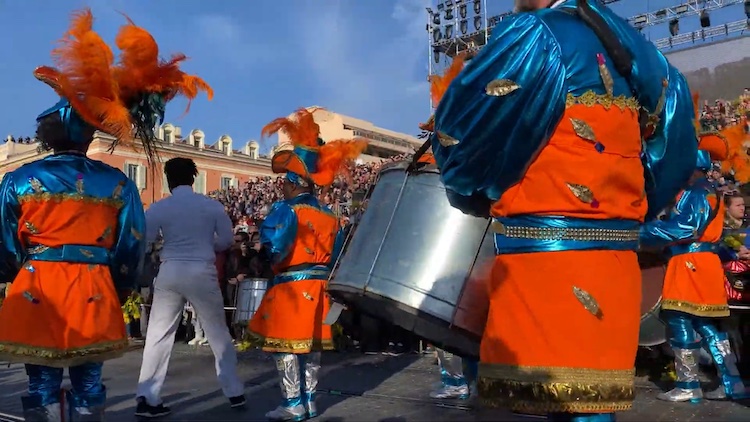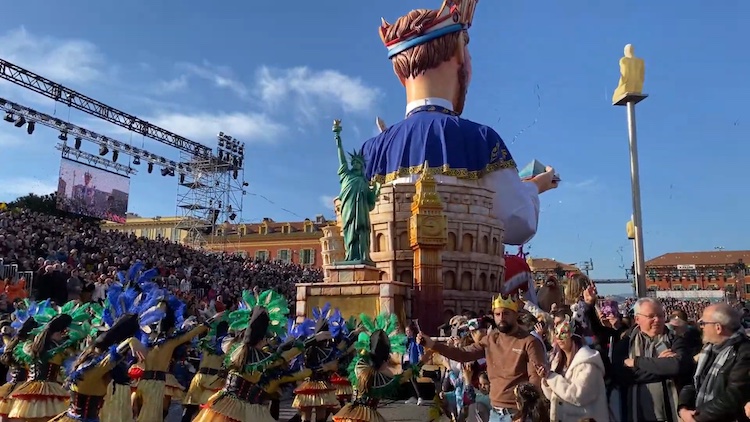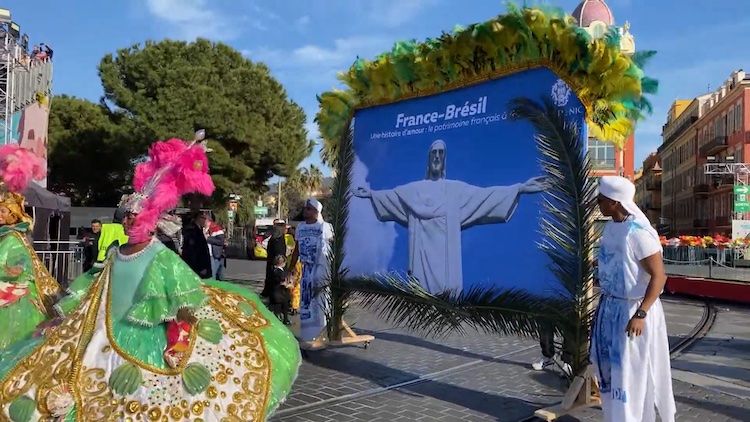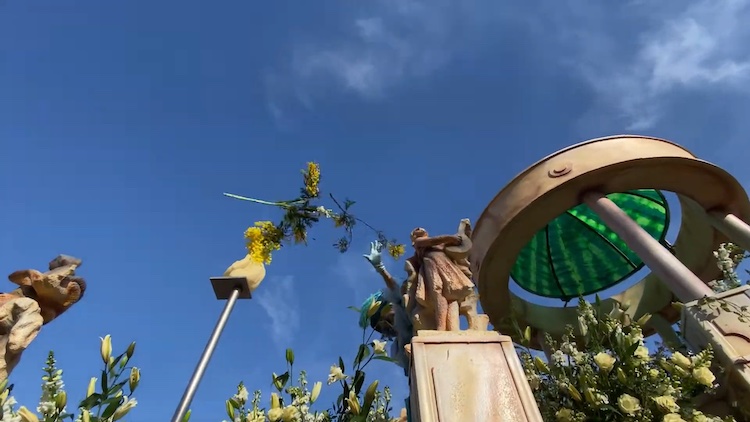Carnival performers reflect on the culture and traditions of the Nice carnival, and the city organizes special celebrations in honor of the anniversary.
“To represent Nice culture is to represent our heritage and our traditions,” says Marion. She is decked in a traditional Niçois dress, a sparkling tiara, and cherry-coloured lips. As the elected “Reine des mais,” she represents Nice culture for an entire year, including at the long-awaited 2023 Nice Carnival.
This year the theme of the Nice carnival—which started on February 10th and runs until the 26th—is “Roi des Trésors du Monde,” or “King of the Treasures of the World.” The parades that take place during the week fall mostly into two categories: Le Corso Caranalesque, and Les Batailles de Fleurs. The former is a traditional parade with burlesque floats, “grosses têtes” meaning “big heads,” musical groups, and more. The second, which translates to “Battle of Flowers,” is a more specific celebration of the regional flora in which performers shower the audience with flower petals. The event is expected to bring in 30 million euros in economic benefits, employ 1800 people, and attract 400 journalists from over twenty countries around the world.
“Carnival is a special celebration for me because it’s a tradition that has been preserved through time,” says Marine, a dancer in a folkloric group that has been performing in the carnival since the age of seven.
But this year’s Nice carnival is particularly special. Not only is it the first normal carnival since Covid-19, but it is also celebrating its 150th anniversary. In honor of the anniversary, the city hosted a unique “Grade Parade Des 150 Ans” on February 11th with an appearance by Nice Mayor Estrosi, and will mark the end of the anniversary with an “emblematic burning” of the King’s Float on February 26th followed by a fireworks show.
Though the Nice Carnival is 150 years old, it hasn’t necessarily taken place 150 times. Major global events have disrupted the beloved tradition, most recently during the Covid-19 pandemic. The 2020 Nice Carnival was celebrated just before the world shut down the following month, but the 2021 edition was canceled, as were all Nice carnivals from 1915 to 1920, from 1941 to 1945, and in 1991, because of the two world wars and the Gulf War, respectively.
Additionally, though the modern Nice carnival is celebrating 150 years, the first written mention of Nice actually dates back to 1294, when Count of Provence Charles d’Anjou cites his passing through the city during “the joyous days of the carnival.” The carnival tradition itself is even older, with some speculating that it might have ties to the ancient Roman celebration of Saturnalia. What remains indisputable is the fact that carnival takes place in the days preceding Lent: a time in which Roman Catholics traditionally fast and avoid eating meat. Coincidentally, some scholars trace the word “carnival” back to the Latin “carnem levare,” meaning “to remove meat.”
But it wouldn’t be an old tradition without a bit of scandal: “It has […] changed a lot over the years,” Marine admits, “It is no longer accessible to everyone, which is a shame, because it’s a popular celebration that should continue to spread through the neighbourhoods of our city.”
Up until a couple of years ago, it seems like the Nice Carnival was mostly free for all. Now, spectators need to purchase tickets to see many of the parades. The change, however, doesn’t seem to have put too much of a damper on the festivities.
Another novelty for the 2023 Nice Carnival is a particular emphasis on its sister city: Rio de Janeiro. Known for hosting perhaps the most famous carnival of all, Brazilian culture made a special appearance during the first weekend of the Nice Carnival. Gabriel Haddad and Leonardo Bora, two Carnavalescos (central figures in the creation of the Rio Carnival floats) designed a Rio-style float for the occasion. In the same spirit, Musée Massena’s central exhibit during the carnival season was curated by Allain Taillard, one of the few Europeans to have climbed the carnival ranks to become a destaque performer in Rio, and is named: “Nice et le Fabuleux Carnaval de Rio,” or “Nice and the Fabulous Rio Carnival.” The exhibit runs from February 2nd to March 5th.
The Nice Carnival is just one of the many cultural events that the city of Nice will be emphasizing in its bid to become the 2028 European Culture Capital. Included on the list of UNESCO World Heritage Sites as the Winter Resort City of the Riviera, the theme of Nice’s application is “Connecter l’inattendu:” connecting the unexpected.
But while the city of Nice starts to lean into this theme, the people continue to celebrate the largely familiar and predictable Nice Carnival: “It’s an event we wait for every year,” Marine concludes, “It’s in respect of our traditions.”
All photos © and courtesy Margherita Bassi






Leave a Reply